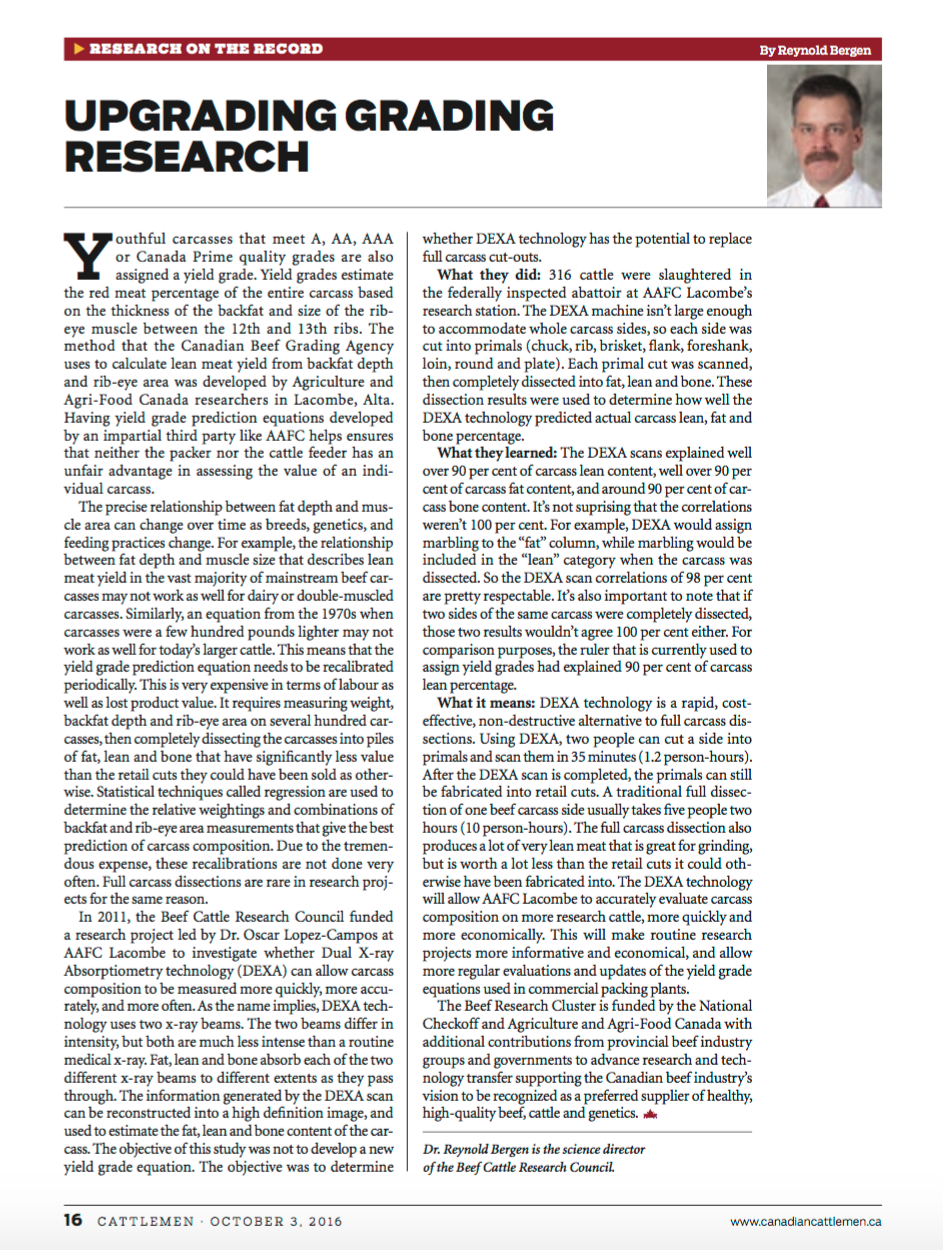Upgrading Grading Research
This article written by Dr. Reynold Bergen, BCRC Science Director, originally appeared in the October 2016 issue of Canadian Cattlemen magazine and is reprinted on the BCRC Blog with permission of the publisher.
Youthful carcasses that meet A, AA, AAA or Canada Prime quality grades are also assigned a yield grade. Yield grades estimate the red meat percentage of the entire carcass based on the thickness of the backfat and size of the ribeye muscle between the 12th and 13th ribs. The method that the Canadian Beef Grading Agency uses to calculate lean meat yield from backfat depth and ribeye area was developed by Agriculture and Agri-Food Canada researchers in Lacombe, Alberta. Having yield grade prediction equations developed by an impartial third party like AAFC helps ensures that neither the packer nor the cattle feeder has an unfair advantage in assessing the value of an individual carcass.
The precise relationship between fat depth and muscle area can change over time as breeds, genetics, and feeding practices change. For example, the relationship between fat depth and muscle size that describes lean meat yield in the vast majority of mainstream beef carcasses may not work as well for dairy or double-muscled carcasses. Similarly, an equation from the 1970’s when carcasses were a few hundred pounds lighter may not work as well for today’s larger cattle. This means that the yield grade prediction equation needs to be re-calibrated periodically. This is very expensive in terms of labor as well as lost product value. It requires measuring weight, backfat depth and ribeye area on several hundred carcasses, then completely dissecting the carcasses into piles of fat, lean and bone that have significantly less value than the retail cuts they could have been sold as otherwise. Statistical techniques called regression are used to determine the relative weightings and combinations of backfat and ribeye area measurements that give the best prediction of carcass composition. Due to the tremendous expense, these recalibrations are not done very often. Full carcass dissections are rare in research projects for the same reason.
In 2011, the Beef Cattle Research Council funded a research project led by Dr. Oscar Lopez-Campos at AAFC Lacombe to investigate whether Dual X-ray Absorptiometry technology (DEXA) can allow carcass composition to be measured more quickly, more accurately, and more often. As the name implies, DEXA technology uses two x-ray beams. The two beams differ in intensity, but both are much less intense than a routine medical x-ray. Fat, lean and bone absorb each of the two different x-ray beams to different extents as they pass through. The information generated by the DEXA scan can be reconstructed into a high definition image, and used to estimate the fat, lean and bone content of the carcass. The objective of this study was not to develop a new yield grade equation. The objective was to determine whether DEXA technology has the potential to replace full carcass cut-outs.
What they did
316 cattle were slaughtered in the federally inspected abattoir at AAFC Lacombe’s research station. The DEXA machine isn’t large enough to accommodate whole carcass sides, so each side was cut into primals (chuck, rib, brisket, flank, foreshank, loin, round, and plate). Each primal cut was scanned, then completely dissected into fat, lean and bone. These dissection results were used to determine how well the DEXA technology predicted actual carcass lean, fat and bone percentage.
What they Learned
The DEXA scans explained well over 90% of carcass lean content, well over 90% of carcass fat content, and around 90% of carcass bone content. It’s not suprising that the correlations weren’t 100%. For example, DEXA would assign marbling to the “fat” column, while marbling would be included in the “lean” category when the carcass was dissected. So the DEXA scan correlations of 98% are pretty respectable. It’s also important to note that if two sides of the same carcass were completely dissected, those two results wouldn’t agree 100% either. For comparison purposes, the ruler that is currently used to assign yield grades had explained 90% of carcass lean percentage.
What it Means
DEXA technology is a rapid, cost-effective, non-destructive alternative to full carcass dissections. Using DEXA, two people can cut a side into primals and scan them in 35 minutes (1.2 person-hours). After the DEXA scan is completed, the primals can still be fabricated into retail cuts. A traditional full dissection of one beef carcass side usually takes five people two hours (10 person-hours). The full carcass dissection also produces a lot of very lean meat that is great for grinding, but is worth a lot less than the retail cuts it could otherwise have been fabricated into. The DEXA technology will allow AAFC Lacombe to accurately evaluate carcass composition on more research cattle, more quickly and more economically. This will make routine research projects more informative and economical, and allow more regular evaluations and updates of the yield grade equations used in commercial packing plants.
Click here to subscribe to the BCRC Blog and receive email notifications when new content is posted.
The sharing or reprinting of BCRC Blog articles is typically welcome and encouraged, however this article requires permission of the original publisher.
We welcome your questions, comments and suggestions. Contact us directly or generate public discussion by posting your thoughts below.
